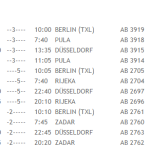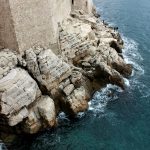October 25, 2019 – The New York Times‘ Alex Crevar reveals all about his 36-hour trip to Rijeka.
“If the coastal regions of Croatia have become tourist stars, then Rijeka, a working-class port city in the Adriatic, is grossly underestimated. It came as a surprise, then, that this city, whose outline combines the Habsburg decadence with the cranes of the shipyard, was proclaimed the European Capital of Culture for 2020 over other Croatian candidates like Dubrovnik and Split,” writes The New York Times in their Rijeka report.
“36 Hours in Rijeka” covered almost every corner of the city through the eyes of American journalist Alex Crevar.
Crevar writes that Rijeka is known for its tumultuous carnival celebrations and alternative vibe, and that it has been a port and shipyard for centuries. “It combines Roman legacy, Italian influence, Austro-Hungarian architecture and the ‘decaying’ Yugoslav industry.
This resulted in a unique blend of sights, cuisine and nightlife. With a series of events set for the 2020 celebrations beginning in February and the five-star Hilton Hotel opening next summer, it seems that this Croatian port is ready to swap its cranes for a spot under the spotlight.”
Cervar begins on Friday afternoon at the Petar Kružić staircase towards the 13th century Trsat Castle. The hilltop offers panoramic views of the Kvarner Bay, the islands and the eastern coast of the Istrian peninsula. “Below is Rijeka – ruled by seven countries since World War I, beautiful in its dissonance.
Green domes amidst terracotta roofs and Renaissance, Baroque and Art Noveau buildings. Italian villas, empty 19th-century warehouses and communist-era blocks fill the space between,” he continues.
Naming a quote by architect Idis Turat: “Rijeka has always had a peripheral existence between empires. In a way, this is an advantage as we ‘re-invent’ the city.”
The author takes us back to the center, where he stops at the Cont pub and drinks a “homemade lager”. He then crosses the Rjecina river and reaches the Croatian National Theatre Ivan pl. Zajc for a show. The theater is said to be a neo-Baroque building with 650 seats, built in 1885 that depicts “Croatian and Italian dramas, ballets and operas.”
Crevar then suggests Konoba na Kantunu for dinner. “Take a table inside the tavern, which is decorated with colorful local canvases, or on the terrace, next to the canal.
Start with a cold octopus, shrimp and squid salad. Order a glass of Zlahtina from the island of Krk and grilled beef served with Swiss cheese and potatoes. For dessert, homemade apple, plum or pear strudel with whipped cream. Lunch for two costs around 450 kuna,” he adds.
On Saturday, Crevar begins with a walk through Korzo, Rijeka’s central pedestrian passage. “Visit the Samovar Bar, a cafe with more than a hundred teas. Pass by the building that is now a chocolate shop, where young Fiorello H. La Guardia served as a US consultant from 1984 to 1906.
Then continue along the coastal side to the town market. Explore open-air kiosks and tables full of fruits and vegetables surrounding three 19th-century iron pavilions selling meats, cheeses, fresh bread, liqueurs, hazelnuts and fresh fish.”
“During Austro-Hungary, Rijeka exported everything – from sugar and paper to playing cards and torpedoes, which were invented here. Start your search for modern local design here in the oldest part of the city – near the remains of Roman Tarsatica.
Inside the shop Sta Da? you will find branded T-shirts, bags and backpacks created from recycled bicycle tubes. You will then arrive at the Bruketa Small Gallery, the city’s oldest private gallery, which opened in 1974. It specializes in individually made ceramics – from watches, vases and lamps to dining sets.”
Crevar also states that around the corner is “Croatia in a Box”, selling handmade crafts (from bags, dresses and necklaces to soap) made of wood. He explains that the concept of this store is summed up in the name. “Create your own version of Croatia in a box. The combination leans toward gastronomy and includes olive oil, wine, sausages, cheese, truffles and chocolate.”
The author continues that nothing is more local than the Konoba Fiume. “This is the kind of restaurant where fishermen sit with lawyers and port workers share a table with politicians,” adding that although medium-priced meals are served (“like homemade shrimp and truffle pasta”), you should close the menu and say one word – brodetto. “And if you ask nicely, you can add juicy shrimp for about 90 kuna.”
The NYT reporter then heads to the “eclectic harbor” and the Maritime and History Museum of the Croatian Littoral at the Renaissance Governor’s Palace. He says the exhibits include Bronze Age discoveries, an interactive model of the city, ancient ship records, and a life jacket from the Titanic.
Crevar continued to “PEEK & POKE,” a museum of old computers and information technology that contains more than seven thousand “objects of technological nostalgia.” Then onto the Museum of Modern and Contemporary Art “which is housed in a complex that once included a sugar factory and a tobacco factory.”
Saturday evening begins at Bard, “one of the first real pubs in the city when it opened in 1998” whose “hobbit-like” interior has not changed. Sitting on the terrace, he mentions the Rijeka Cathedral and the Rijeka tunnel built before World War II.
“Take the river that used to be the border between Italy and Yugoslavia, between the world wars, to dinner at Konoba Nebuloza. The NYT praises the offer, which includes “travarica, shrimp risotto, polenta, and red Istrian Teran.”
“It seems like everyone in Rijeka is either a DJ or they are in a band,” Crevar said. He added that for a better understanding of the city vibe, it is necessary to make a circle along the river and the former industrial zone. “Begin the evening with a Niksic beer at the Caffe Bar Skradin, a family-owned place to drink full of memorabilia that includes old radios and tickets from 1964.”
He then heads to the Tunel, which “blends art exhibitions, jazz and alternatives with a local dance rhythm.” He ends the evening at “Zivot”, which “spins electronic and house in a disco decorated with family photographs from Yugoslavia in the 1980s.”
You can read the full report at The New York Times.
Translated from Novi List
To read more about travel in Croatia, follow TCN’s dedicated page.









